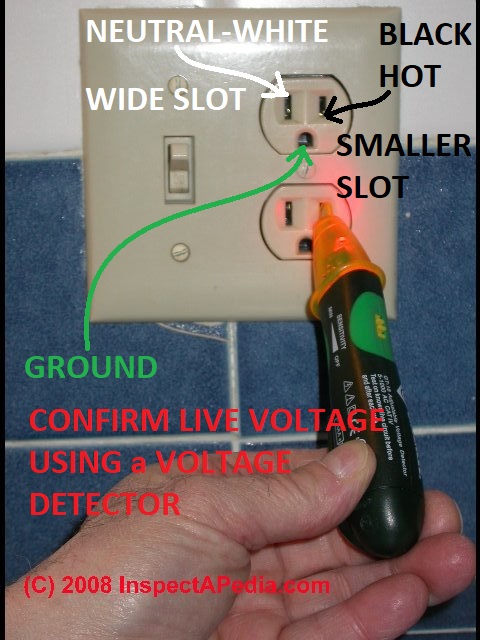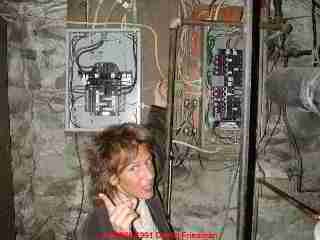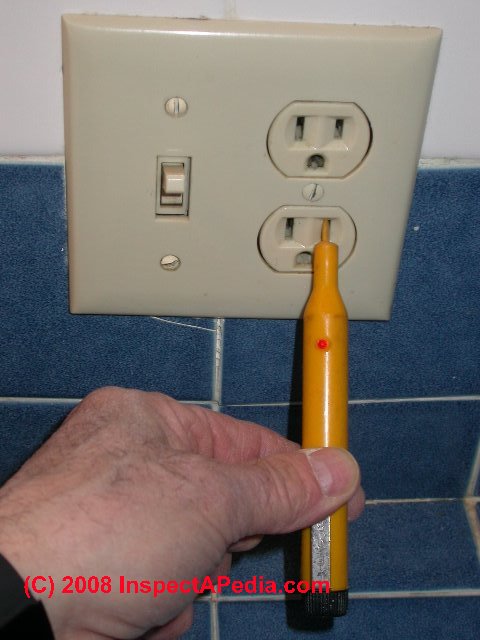 Electric Shock Hazards when Touching Electrical Equipment
Electric Shock Hazards when Touching Electrical Equipment
Safety Hazards and Electrical Inspection Procedures
- POST a QUESTION or COMMENT about shock and electrocution hazards when touching electrical equipment during an inspection
Hazards of touching electrical equipment - safety procedures: this article reviews safe and unsafe methods for touching or not-touching electrical equipment during its inspection. Warning: photographs in the article below include one of a gruesome death by electrocution.
Electrical safety is an important consideration for both workers and building owners/occupants, and the hazards are real.
This is a chapter of our article on electrical safety procedures which discusses safety hazards at residential electrical panels and suggests safety procedures for the electrical inspector, home inspector, or other professionals who examine residential electrical systems.
InspectAPedia tolerates no conflicts of interest. We have no relationship with advertisers, products, or services discussed at this website.
- Daniel Friedman, Publisher/Editor/Author - See WHO ARE WE?
Dangers of touching electrical equipment during an inspection

Safe electrical inspection procedures and safe use of volt meters, DMMs, multimeters, and similar electrical test equipment is discussed at the end of the article. Original text: DF, as ASHI Technical Journal Staff, January 1992, with updates February 2006.
Watch out: See SAFETY for ELECTRICAL INSPECTORS. Never touch metal plumbing or gas system pipes while you're working around electricity. Never touch electrical equipment while standing on a damp or wet surface.
During an inspection an ASHI inspector warned the home owner that there was a short in a florescent ceiling light fixture.
The owner, a contractor who had done his own electrical work, irritated and incredulous at this supposed defect, licked his knuckles and bridged a small space between the light body and a nearby gas pipe.
He's now a believer. [NOTE: DJF home inspection, Beacon, NY 1990]
From a safety view, this is a bad idea. Never rely on physical touch to judge electrical safety of a component. Use instruments.
Test instruments such as the VOM described above, and the TIFTM Tic Tracer shown at left are inexpensive, effective, safer when used properly.
NOTE: Alexandra Radkewycz, a Canadian researcher, reports severely shocking experiences from failure to make proper use of instruments. [Private communication to author, 12/91.]
We describe the TIF Tic Tracer in detail, including providing examples of its use,
at VOLTS / AMPS MEASUREMENT EQUIP.
Electrocution Hazards from Touching Electrical Equipment
 The gruesome death by electrocution shown in the photograph linked-to here occurred when the man shown tried to steal electrical power from a high voltage cable. - Jim Simmons
The gruesome death by electrocution shown in the photograph linked-to here occurred when the man shown tried to steal electrical power from a high voltage cable. - Jim Simmons
You can click the image to see the enlarged, un-censored photograph - giving us a critical life-safety warning:
Watch out:
- Never touch metal plumbing or gas system pipes while you're working around electricity.
- Never touch electrical equipment while standing on a damp or wet surface. [Unless you are trained and are wearing appropriate protective gear.]
Shocked homeowner:
During an inspection an ASHI inspector warned the home owner that
there was a short in a florescent ceiling light fixture. The owner,
a contractor who had done his own electrical work, irritated and
incredulous at this supposed defect, licked his knuckles and bridged
a small space between the light body and a nearby gas pipe. He's now
a believer. [NOTE: DJF home inspection, Beacon, NY 1990]
Amazing Albert Alk:
A very questionable procedure is suggested in The ASHI Training
Manual [ "Electrical Systems," ASHI Training Manual,
chapter by Alfred L. Alk, p. 18. ASHI 1987] indicating that the
inspector can "test" to see if a panel is dangerously "live"
(has an internal short) by tapping the box with the knuckles of his/her
right hand to check for current, then laying the right palm on the
box to feel for heat before beginning to remove the cover.
Watch out: DO NOT RELY ON THESE UNSAFE METHODS.
Babbling Bob Smith:
an electrician asked to lecture to home inspectors at a conference we organized advised that home inspectors should check the security of the incoming mains connections at the electrical panel by grabbing the wires and giving them a good shake and pull.
His advice was so mistaken that we were forced to interrupt the lecture to exclaim and issue a warning lest Bob's advice kill some of the attendees.
Watch out: DO NOT DO THIS. While an experienced electrician, wearing proper safety equipment, will in some circumstances have to touch or hold live electrical wires, there is risk of death by electrocution. This wire grabbing and shaking is not something that a home inspector or home owner should ever attempt.
From a safety view, these are bad ideas that can kill someone. Never rely on physical touch to judge electrical safety of a component.
Use electrical test instruments to check for live voltage.
 Test instruments such as the VOM described above, and the
TIFTM Tic Tracer (above), and the contact and "touchless" pens (photo at left) and tools used to detect the presence of voltage are inexpensive, effective,
safer when used properly.
Test instruments such as the VOM described above, and the
TIFTM Tic Tracer (above), and the contact and "touchless" pens (photo at left) and tools used to detect the presence of voltage are inexpensive, effective,
safer when used properly.
[Alexandra Radkewycz, a Canadian researcher, reports severely shocking experiences from failure to make proper use of instruments. Private communication to author, 12/91.]
See VOLTS / AMPS MEASUREMENT EQUIP for a description of tools used to detect the presence of live electrical wires & devices and for the measurement of actual volts or amps.
See DMMs VOMs SAFE USE OF for details about using test equipment during an electrical inspection.
In the same ASHI Training Manual chapter the author, Al Alk, offers another more accepted suggestion: "Inspectors should practice working around open enclosures with the left hand behind the back.
If the right hand receives a shock the current will more likely pass down the right half of the body: the heart is on the left side. Inspectors who wear rings must be especially wary when working near an open box." [NOTE: ASHI Training Manual, Op. Cit.- Obsolete]
Grounding: A basic rule for working around electrical equipment: if you are yourself not grounded, and if you only touch one single component at a time, risks are reduced.
Never ground yourself through your feet. Don't stand on a wet floor. If it's necessary to touch electrical components in such a location, a trained electrical worker uses a dry ungrounded platform such as boards or a wooden ladder.
Rings and watches: When working around electrical equipment, first remove rings and watches to reduce the risk of electric shock. At an IBM test site in Poughkeepsie, NY in the 1980's a test technician was killed while working on a computer.
His metal watch band contacted a live component while other body parts were touching a grounded component, possibly the steel frame of the assembly. Similar accidents around electric panels are a real risk for home inspectors.
Electric Panel cover screws: if you find that a sharp-tipped sheet metal screw has been used (usually to replace a lost original fastener) you should be alert for pierced, damaged, short-circuited wires in the panel - both during removal and during panel cover replacement. We will not reinstall a sharp-pointed screw in a panel cover if wires are crowded close to the screw opening. Having seen more than one shorted and burned panel from precisely this cause, we warn clients about this unsafe detail. It is trivial to correct.
Never Assume You've Turned Power Off - Use a Neon Tester, Voltage Detector, or Multimeter
A simple neon tester with two probes that are touched to wires or other electrical connectors, and a more-safe voltage pen, shown below.
'I'm holding the yellow voltage pen near the opening of an electrical outlet and the pen buzzes and its light ignites, showing the presence of live voltage without actually touching live devices or wires.
The most basic electrical safety procedure I can think of when working on electrical devices or electrical wiring involves knowing how to:
- turn off power to the device or circuit or system where you're planning to work
- make sure that power is really OFF there
I never touch something electrical that I've "turned off" without using at least a neon tester to or a voltage detection pen to see that electrical power is really off.
In 1970 I turned off power to a junction box to fix a light - the light went out - so I figured that all electrical power to the junction box was really off. Then while wiggling wires in the junction box I got a huge spark and a little shock.
Some nitwit had run two different live circuits into the same junction box.
Now I'm more careful. I figure that if you don't electrocute yourself, the rest is easy - you can always run out of a burning building. Well really inspectors have more responsibility than that: in addition to not killing yourself, you must protect the safety of your clients and of the occupants of buildings on which you've performed work.
...
Continue reading at DMMs VOMs SAFE USE OF or select a topic from the closely-related articles below, or see the complete ARTICLE INDEX.
Or see these
Recommended Articles
- DMMs VOMs SAFE USE OF
- SAFETY for ELECTRICAL INSPECTORS
- VOLTAGE MEASUREMENT EQUIPMENT - voltage sensors, DMMs, VOMs, and other choices of equipment we use for testing electrical circuits and for performing basic electrical or appliance wiring repairs.
Suggested citation for this web page
TOUCHING ELECTRICAL EQUIPMENT at InspectApedia.com - online encyclopedia of building & environmental inspection, testing, diagnosis, repair, & problem prevention advice.
Or see this
INDEX to RELATED ARTICLES: ARTICLE INDEX to ELECTRICAL INSPECTION & TESTING
Or use the SEARCH BOX found below to Ask a Question or Search InspectApedia
Ask a Question or Search InspectApedia
Questions & answers about shock and electrocution hazards when touching electrical equipment during an inspection.
Try the search box just below, or if you prefer, post a question or comment in the Comments box below and we will respond promptly.
Search the InspectApedia website
Note: appearance of your Comment below may be delayed: if your comment contains an image, photograph, web link, or text that looks to the software as if it might be a web link, your posting will appear after it has been approved by a moderator. Apologies for the delay.
Only one image can be added per comment but you can post as many comments, and therefore images, as you like.
You will not receive a notification when a response to your question has been posted.
Please bookmark this page to make it easy for you to check back for our response.
IF above you see "Comment Form is loading comments..." then COMMENT BOX - countable.ca / bawkbox.com IS NOT WORKING.
In any case you are welcome to send an email directly to us at InspectApedia.com at editor@inspectApedia.com
We'll reply to you directly. Please help us help you by noting, in your email, the URL of the InspectApedia page where you wanted to comment.
Citations & References
In addition to any citations in the article above, a full list is available on request.
- Electrical shock injury statistics: www.healthatoz.com - September 2008;
High-tension current generally causes the most serious injuries, although fatal electrocutions may occur with household current (e.g., 110 V in the United States and Canada and 220 V in Europe, Australia, and Asia). Contact with alternating current at 60 cycles per second (the frequency used in most US household and commercial sources of electricity) may cause tetanic skeletal muscle contractions, preventing self-release from the source of the electricity and thereby leading to prolonged exposure. The repetitive frequency of alternating current also increases the likelihood of current flow through the heart during the relative refractory period (the "vulnerable period") of the cardiac cycle. This exposure can precipitate ventricular fibrillation (VF), which is analogous to the R-on-T phenomenon.-- circ.ahajournals.org - September 2008
- Mark Cramer Inspection Services Mark Cramer, Tampa Florida, Mr. Cramer is a past president of ASHI, the American Society of Home Inspectors and is a Florida home inspector and home inspection educator. Mr. Cramer serves on the ASHI Home Inspection Standards. Contact Mark Cramer at: 727-595-4211 mark@BestTampaInspector.com
- John Cranor [Website: /www.house-whisperer.com ] is an ASHI member and a home inspector (The House Whisperer) is located in Glen Allen, VA 23060. He is also a contributor to InspectApedia.com in several technical areas such as plumbing and appliances (dryer vents). Contact Mr. Cranor at 804-873-8534 or by Email: johncranor@verizon.net
- "Frequency of Occurrence and Sources of Rust and Corrosion in Electrical Panels," Daniel Friedman, IEEE HOLM Conference, Philadelphia PA, 1992 - see ELECTRIC PANEL RUST for an online version of this article.
- Jim Simmons: Personal communication, J. Simmons to Daniel Friedman, 9/19/2008. Photographs contributed to this website by Jim P. Simmons, Licensed Electrician, 360-705-4225 Mr. Electric, Licensed Master Electrician, Olympia, Washington Contact Jim P. Simmons, Licensed Master Electrician, Mr. Electric, 1320 Dayton Street SE
Olympia, WA 98501, Ph 360-705-4225, Fx 360-705-0130 mrelectricwa@gmail.com - Kenneth Kruger: Original author of the sidebar on testing VOM DMM condition: Kenneth Kruger, R.A., P.E. AIA ASCE, is an ASHI Member and ASHI Director in Cambridge, MA. He provided basis for this article penned by DJ Friedman.
- "How to Use DMM's Safely," Leonard Ogden, CEE News, 888 Seventh Ave., New York, NY 10106, Dec 1990 p.10.
- Dr. Jess Aronstein, consulting engineer, Poughkeepsie NY, 1991 protune@aol.com
- Rex Cauldwell, master electrician and contributor to the Journal of Light ConstructionOn electrical topics
- New York State Central Hudson Gas and Electric Company, G&E/1-2/85 consumer safety pamphlet
- American Society of Home Inspectors, ASHI Training Manual, Al Alk -[obsolete, and includes unsafe practices-DF]
- * Safety Hazards and Safe Inspection Procedures for Electrical and Home Inspectors at Residential Electric Panels
- "Electrical System Inspection Basics," Richard C. Wolcott, ASHI 8th Annual Education Conference, Boston 1985.
- "Simplified Electrical Wiring," Sears, Roebuck and Co., 15705 (F5428) Rev. 4-77 1977 [Lots of sketches of older-type service panels.]
- "How to plan and install electric wiring for homes, farms, garages, shops," Montgomery Ward Co., 83-850.
- "Simplified Electrical Wiring," Sears, Roebuck and Co., 15705 (F5428) Rev. 4-77 1977 [Lots of sketches of older-type service panels.]
- "Home Wiring Inspection," Roswell W. Ard, Rodale's New Shelter, July/August, 1985 p. 35-40.
- "Evaluating Wiring in Older Minnesota Homes," Agricultural Extension Service, University of Minnesota, St. Paul, Minnesota 55108.
- "Electrical Systems," A Training Manual for Home Inspectors, Alfred L. Alk, American Society of Home Inspectors (ASHI), 1987, available from ASHI. [DF NOTE: I do NOT recommend this obsolete publication, though it was cited in the original Journal article as it contains unsafe inaccuracies]
- "Basic Housing Inspection," US DHEW, S352.75 U48, p.144, out of print, but is available in most state libraries.
- Roger Hankey is principal of Hankey and Brown Inspections, Winter Park, CO. Mr. Hankey is a past chairman of the ASHI Standards Committee and served in other ASHI chapter and national leadership roles. Mr. Hankey is a National Radon Proficiency Program certified measurement professional and a Level II infrared thermographer. Contact Roger Hankey at: 970-393-6604 - rogerhankey47@gmail.com . Website: www.HankeyandBrown.com Mr. Hankey is a frequent contributor to InspectAPedia.com.
- Arlene Puentes [Website: www.octoberhome.com ] , an ASHI member and a licensed home inspector in Kingston, NY, and has served on ASHI national committees as well as HVASHI Chapter President. Ms. Puentes can be contacted at ap@octoberhome.com
-
Electrical Books section of the InspectAPedia Bookstore. (courtesy of Amazon.com)
- In addition to citations & references found in this article, see the research citations given at the end of the related articles found at our suggested
CONTINUE READING or RECOMMENDED ARTICLES.
- Carson, Dunlop & Associates Ltd., 120 Carlton Street Suite 407, Toronto ON M5A 4K2. Tel: (416) 964-9415 1-800-268-7070 Email: info@carsondunlop.com. Alan Carson is a past president of ASHI, the American Society of Home Inspectors.
Thanks to Alan Carson and Bob Dunlop, for permission for InspectAPedia to use text excerpts from The HOME REFERENCE BOOK - the Encyclopedia of Homes and to use illustrations from The ILLUSTRATED HOME .
Carson Dunlop Associates provides extensive home inspection education and report writing material. In gratitude we provide links to tsome Carson Dunlop Associates products and services.




